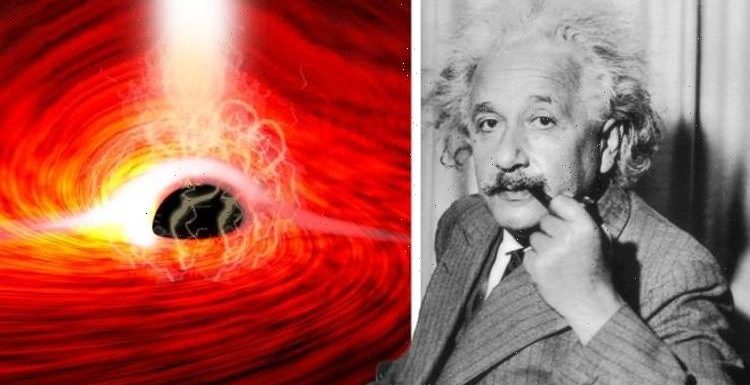
Black hole: Brian Cox says we 'know nothing' about the centre
We use your sign-up to provide content in ways you’ve consented to and to improve our understanding of you. This may include adverts from us and 3rd parties based on our understanding. You can unsubscribe at any time. More info
The groundbreaking discovery was achieved by a team of international astronomers led by researchers at Stanford University in the US. Using powerful X-ray telescopes, the researchers honed in on a supermassive black hole at the centre of a galaxy some 800 million light-years away. What at first glance appeared to be a regular source of X-ray flares, soon revealed something completely unexpected: flashes of X-ray light reflected from behind the black hole.
The discovery, which was published in the journal Nature on Wednesday, July 28, is in line with Albert Einstein’s monumental theory of general relativity.
Conventional wisdom states the gravitational tug of a black hole is so powerful, not even light can escape its clutches.
This is precisely why black holes are considered “black” – we simply cannot see them.
We can, however, see the various phenomena happening around black holes, such as their scorching accretion disks and X-ray signatures.
Dan Wilkins, an astrophysicist at the Kavli Institute for Particle Astrophysics and Cosmology at Stanford, said: “Any light that goes into that black hole doesn’t come out, so we shouldn’t be able to see anything that’s behind the black hole.”


But thanks to the theoretical predictions made by Einstein’s theories in 1915, the properties of a black hole make it possible to see what lurks behind it.
Dr Wilkins said: “The reason we can see that is because that black hole is warping space, bending light and twisting magnetic fields around itself.”
The discovery marks the very first time scientists have made a direct observation of light from behind a black hole – more than a century after Einstein predicted it was possible.
According to Einstein, gravity as we know it is not a force, but rather a warping of space and time (spacetime) caused by objects with mass.
In other words, light travelling from behind a black hole can appear on the other side by travelling along the warped magnetic fields and spacetime.
So what better way to observe the warping of spacetime than in the presence of a black hole – one of the heaviest objects in the known universe?
Roger Blandford, professor of particle physics and study co-author, said: “Fifty years ago, when astrophysicists starting speculating about how the magnetic field might behave close to a black hole, they had no idea that one day we might have the techniques to observe this directly and see Einstein’s general theory of relativity in action.”
Black hole: Scientists discover one of smallest on record
And this is not the first time astronomers have looked at a black hole to verify Einstein’s theories – the theory of relativity was proven by the world’s first-ever picture of a black hole two years ago.
Wind the clocks back by more than 100 years and scientists were also able to prove relativity in action during a solar eclipse.
Supermassive black holes are the biggest type of black hole, weighing millions to billions of times more than our Sun.
One theory suggests these monstrous wells of gravity are born when clusters of stars collide and form intermediate-mass black holes, which then merge over time into supermassive black holes.
According to the US space agency NASA, a supermassive black hole sits at the centre of most galaxies.
The one at the heart of the Milky Way, for instance, is a behemoth known as Sagittarius A* (read: A-Star).


Dr Wilkins and his team observed one of these giants to learn more about its corona.
As material falls towards a black hole, it is superheated to temperatures of millions of degrees.
The mindboggling heat causes electrons to separate from atoms of gas, creating a magnetised plasma – an ionised gas of superheated, free-flowing particles.
Trapped in the black hole’s spin, the magnetic field arcs upward and twirls around itself.
Consequently, it breaks up in a phenomenon that is similar to what happens in our Sun’s corona – its outermost layer.
Dr Wilkins said: “This magnetic field getting tied up and then snapping close to the black hole heats everything around it and produces these high energy electrons that then go on to produce the X-rays.”
As the researcher and his colleagues took a closer look at these X-ray flares, they noticed a pattern of smaller flashes.
They eventually realised they were looking at the same flares but coming from the back of the black hole’s disk.
Dr Wilkins added: “I’ve been building theoretical predictions of how these echoes appear to us for a few years.
“I’d already seen them in the theory I’ve been developing, so once I saw them in the telescope observations, I could figure out the connection.”
The astronomers are now looking to continue their work with the aid of Athena – a powerful X-ray observatory built by the European Space Agency (ESA).
According to Dr Wilkins, the observatory has a much bigger mirror than any X-ray telescope and will allow for observations at higher resolutions.
He added: “So, the picture we are starting to get from the data at the moment is going to become much clearer with these new observatories.”
Source: Read Full Article